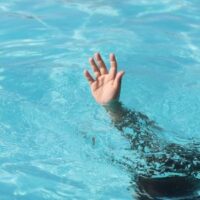Most People Can’t Recognize the Signs of Drowning

Let’s imagine that you are near a pool. You are supervising a bunch of people in the pool, and you’re a strong swimmer. You know you could rescue someone in need, if they were under distress while in the water. But even if you could rescue them—would you even know if they were drowning?
It sounds like a silly question, but you may be surprised at how difficult it can be, to tell whether or not someone is drowning. The signs and indications of drowning simply don’t look the way they are often portrayed in movies or on TV, or how we would intuitively think drowning looks like.
A Quiet Process With Subtle Signs
We tend to picture a drowning person as frantically splashing about, while screaming for help. But there is actually an eerie silence to drowning, which can happen much more subtly than you think.
The notion that a person will be splashing about is usually not the case, because often, the victim’s arms are under water. And because the arms are occupied with trying to wade, and tread water, they are not able to grab onto nearby objects—one reason you should never assume someone in the water is OK, just because they are near a floating device, or the edge of the pool.
People drowning, do not scream. They are frantically trying to hold their breath, or get gulps of air whenever they can. They do not waste valuable oxygen screaming, and may not even be above water long enough to let out a scream.
Many people in distress in the water will close their mouths and eyes to keep water from getting in either one. This means that someone in distress may not look for you, see objects or the edge of the pool near them, or even know if help is around them.
Body Positioning
It may sound odd, but rolling on the back in the water is a big distress signal, one that is often missed, because someone supervising may figure the person is rolling over so they must be OK. They often do this, again, to keep their facial features above water.
You may also notice that someone seems to have a lot of movement—arms and legs paddling for example—but they aren’t really going anywhere in the water. This is also a sign of distress in the water.
Simply Asking Can Help
As someone who may be watching others in the water or the pool, one of the best things you can do is simply ask if the person is OK. Usually, if someone can answer, they are OK, at least for the moment. It’s when you ask, and you get no response, that you should be immediately concerned.
Remember that you don’t have to be a trained lifeguard to have responsibility to watch others in the water—especially if others, particularly minors, are in your care. Schedule a consultation with the Tampa personal injury lawyers at Barbas, Nunez, Sanders, Butler & Hovsepian today if you or anybody you love has been injured in a pool.
Sources:
statefarm.com/simple-insights/family/how-to-recognize-drowning-signs
stopdrowningnow.org/uncategorized/recognizing-the-signs-of-drowning-what-to-look-for-and-how-to-react/
